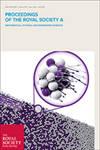Mathematical formulation and analysis of a continuum model for tubulin-driven neurite elongation
Proceedings of the Royal Society of London. Series A. Mathematical and Physical Sciences
Pub Date : 2004-08-08
DOI:10.1098/rspa.2004.1288
引用次数: 20
Abstract
A partial–differential–equation model of neurite growth is developed. This model is the first of its kind and uses a continuum mechanical approach to model the effects of active transport, diffusion and species degradation of the oligomer tubulin, which is used in the elongation of a single neurite. The model problem is mathematically difficult since it must be solved on a dynamically growing domain. The development and implementation of a spatial transformation to a neurite length coordinate simplifies the problem. Existence and uniqueness of solutions to the steady–state problem are found and shown to be equivalent to solving a nonlinear equation for the steady–state length. This expression is not directly solvable except in certain degenerate cases. However, one system parameter is naturally small and permits solutions in terms of asymptotic series. We identify three growth regimes analytically and verify them numerically. It is then evident that a neuron may easily regulate the extent of its own neuritic growth by increasing or decreasing its tubulin production relative to the active transport/degradation fraction.微管蛋白驱动的神经突延伸连续模型的数学公式和分析
建立了神经突生长的偏微分方程模型。该模型是同类模型中的第一个,它使用连续力学方法来模拟微管蛋白的主动运输、扩散和物种降解的影响,微管蛋白用于单个神经突的伸长。模型问题在数学上是困难的,因为它必须在一个动态增长的域上求解。开发和实现到神经突长度坐标的空间变换简化了问题。发现了稳态问题解的存在唯一性,并证明了其等价于求解稳态长度的非线性方程。这个表达式不是直接可解的,除非在某些简并情况下。然而,有一个系统参数自然很小,并且允许解以渐近级数形式存在。我们通过分析确定了三种增长机制,并对其进行了数值验证。因此,很明显,神经元可以通过增加或减少相对于主动运输/降解部分的微管蛋白产生来容易地调节其自身的神经生长程度。
本文章由计算机程序翻译,如有差异,请以英文原文为准。
求助全文
约1分钟内获得全文
求助全文
来源期刊
自引率
0.00%
发文量
0
期刊介绍:
Proceedings A publishes articles across the chemical, computational, Earth, engineering, mathematical, and physical sciences. The articles published are high-quality, original, fundamental articles of interest to a wide range of scientists, and often have long citation half-lives. As well as established disciplines, we encourage emerging and interdisciplinary areas.

 求助内容:
求助内容: 应助结果提醒方式:
应助结果提醒方式:


